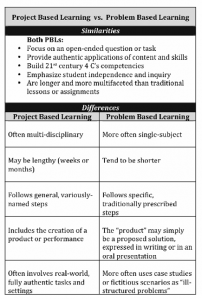28 Project-Based Learning
Teaching Strategies: Project-Based Learning
Project-Based Learning, like problem-based learning, is a teaching method by which students explore the content through solving a problem, challenge, or the completion of some project. The elements of PBL that make it successful are (adapted from http://bie.org/about/what_pbl):
- Significant Content
- 21st-century competencies
- In-Depth Inquiry
- Driving Question
- Need to Know
- Voice and Choice
- Critique and Revision
- Public Audience
Projects typically present students with a problem to solve; a dilemma to investigate; a decision to make; or a challenge to overcome. Projects should promote critical thinking and give students an opportunity to apply the content. Projects should not be “busy work” such as posters, dioramas, building models, volcanoes, etc. Meaningful projects should have driving questions, much like good essays should have thesis statements. An example biology project might be: How can we reduce the number of days Foster’s Beach is closed because of poor water quality? (Larmer & Mergendoller, 2010).
Employing this strategy can be rewarding but takes careful planning to give your students the tools they need to complete the project – we have created a planning document that walks you through the steps to creating a comprehensive lesson based on PBL, which can be found here: Project-Based Learning Instruction Planning Template
This section outlines how you might begin to think about adopting this teaching strategy and the tools you might consider employing.
- Problem-based learning, also called PBL, presents a fully formed “real-world” problem to students at the outset of a course.

From: Larmer, John. Project-Based Learning vs.Problem-Based Learning vs. X-BL
- Online collaborative tools are useful for project-based learning. One Drive allows students to share documents in the cloud. Mind mapping tools can help students brainstorm and create logic chains to solve the problem.
On the Web
- Seven Essentials for Project-based learning
- Project-based Learning (BIE)
- Project-based Learning (Edutopia)
References
Henrichs, L. (2003). Project-based learning: Is it supported by john Dewey’s educational philosophy?
Licht, M. (2014). Controlled chaos: Project-based learning. Education Digest, 80(2), 49.
Melin, U., Wedlund, T., Axelsson, K., Handelshögskolan vid Örebro universitet, & Örebro universitet. (2009). Project-based learning: An emergent framework for designing courses. Information Systems Education Journal, 7, 34.
Metz, S. (2015). Project-based science learning. The Science Teacher, 82(1), 6.

